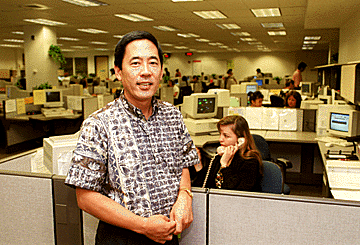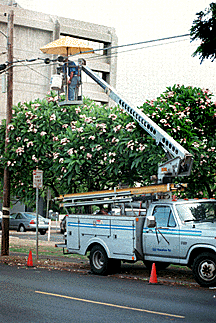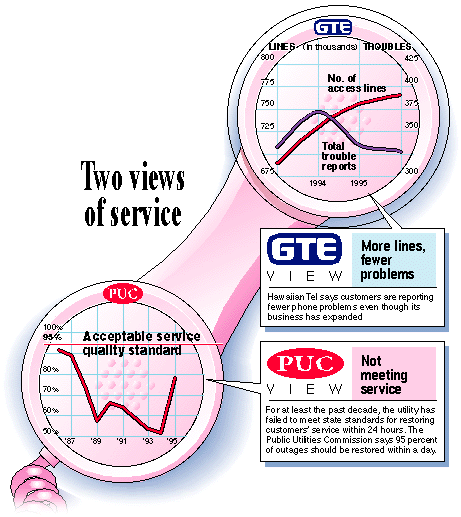
Warren Haruki, president of GTE Hawaiian Tel.
Photo by Ken Sakamoto, Star-Bulletin

Warren Haruki, president of GTE Hawaiian Tel.
Photo by Ken Sakamoto, Star-Bulletin
The gathering was supposed to be part cheerleading session, part employee briefing. An upbeat company video was shown featuring Hawaiian Tel President Warren Haruki, bedecked in trench coat and hat, playing a detective-like character checking out the utility's competition.
Names of competitors were flashed on the screen, only to be karate-chopped into oblivion by company employees, cartoon-style. The message was clear: The other guys were no match for Hawaiian Tel.
But not everything was so upbeat off the screen.
When one executive was introduced, he was booed. Some workers used a question-and-answer session with Haruki to disparage management.
The incidents underscored that all is not rosy at Hawaiian Tel - even as it faces the most challenging period in its long and colorful history.
After more than 100 years as the state's only local phone company, Hawaiian Tel is entering uncharted territory.
It is preparing to do battle with a slew of competitors, and the outcome will affect everyone with phone service in Hawaii.
The company enters this new era facing significant challenges:
The level of bitterness cuts so deep that longtime employees are openly critical of the company.
"We've been trashed," said George Stender, 50, a switching technician with 31 years at Hawaiian Tel. "It's like a dog. If someone keeps abusing and hitting it, the pet will take the abuse for a while. But one day it'll turn around and bite back."
Haruki acknowledges that the company faces tough times. But he said the utility has been preparing for years and is up to the challenge.
Over the past five years, Hawaiian Tel has spent more than $800 million to upgrade its phone network. Services have been added and efficiency and reliability boosted - all key to becoming more competitive, Haruki said.
"The absolute results clearly indicate our service has improved over the past several years," he said, referring to several measures, including a decline in customer trouble reports since 1994.
Haruki attributed morale problems to the contract dispute and the changes sweeping the company.
 GTE repair crews were cut 20 percent between January 1993 and December 1995. Photo by Terry Luke, Star-Bulletin
GTE repair crews were cut 20 percent between January 1993 and December 1995. Photo by Terry Luke, Star-Bulletin
But he said most workers are dedicated and focused on customer service, and they know their job security will be enhanced by the company's success.
"A unified work force is essential if you're going to beat the competition," Haruki said.
Carla Brede, a 27-year Hawaiian Tel worker on Molokai, agreed. She said most employees can put aside their frustration with the contract dispute and focus on doing their jobs.
"In order for us to keep working, we better keep our customers happy," said Brede, a union steward.
Executives at other telecom companies say Haruki has a difficult task ahead.
"You put all those (problems) together and that's a morass I would want no part of if I'm trying to run a business," said AT&T Hawaii's Ken Sandefur, who saw similarly wrenching change following AT&T's forced breakup in the 1980s.
"Everyone will have difficulty taking market share from GTE," said Edward Murley, state regulatory director for Oceanic Communications, which is building a competing network on Oahu. "It would be very hard to devise a battle that is more one-sided than what we're facing now."
One of Hawaiian Tel's chief weapons thus far has been pricing. In the face of impending competition, the company has resorted to aggressive discounting to keep customers.
When AT&T and Sprint were entering the interisland toll market last year, Hawaiian Tel offered some of its major business customers substantial discounts if they signed three-year contracts - long-term by industry standards.
The danger with such a strategy is that Hawaiian Tel can price would-be competitors out of the market even before they get established, defeating the purpose of deregulation, according to state consumer advocate Chuck Totto.
Another concern: Hawaiian Tel could offset the discounts by shifting costs to "captive" customers in its monopoly markets, Totto said. He said residential customers already pay more than they should because of such shifting - a charge the company denies.
Haruki said the discounts are part of an overall strategy to adjust rates to reflect the actual cost of delivering service. Pending regulatory approval, the utility wants to make the adjustments - which will mean higher residential rates - so it can be more price competitive.
"This company is no longer run by technical people. It's run by bean counters," said Daniel Ferguson, 52, who has 28 years with Hawaiian Tel.
Patrick Sambueno, 55, a former Hawaiian Tel manager who retired in February after getting a layoff notice, said the company is neglecting preventive maintenance to save money.
When he inspected the utility's central offices - the brains of the phone system - before retiring, Sambueno said he found emergency generators that were broken or hadn't been tested in months, battery banks leaking onto floors or with insufficient water levels, first-aid kits missing supplies and fire extinguishers that hadn't undergone required safety checks.
"A lot of people are getting fed up or disgusted," Sambueno said. "If they have a choice to retire, they retire. They want out."
Dale Parham, Hawaiian Tel's general manager of customer operations, disputed the notion that the company is cutting corners on preventive maintenance. He also dismissed Sambueno's claims as inaccurate.
Hawaiian Tel far exceeds certain state-imposed standards that couldn't be met if preventive maintenance was deficient, Parham said. And the standards are among the toughest in the nation, he said.
"Our emphasis is on reliability and dependability," Haruki agreed.
Such assurances apparently haven't appeased regulators.
Norman Lee, a consultant hired by the consumer advocate's office to analyze Hawaiian Tel's customer service, says regulators are concerned the utility will react to competition by cutting costs excessively.
If that happens, service quality may be the first to suffer, especially in markets where the company still holds a monopoly, Lee said in written comments filed with the state Public Utilities Commission. He declined to be interviewed for this story.
Lee said he was unable to directly link Hawaiian Tel's past downsizing to substandard measures of service quality, but it appears the reductions may have been excessive.
He noted that the utility cut its installation and repair crews by 20 percent between January 1993 and December 1995.
Yet the company for at least the past decade has failed to meet minimum standards for restoring customers' phone service within 24 hours, according to Lee. A company's record on service restoration, he said, is one of the most critical quality measures - a contention the company disputes.
Haruki and Parham note that the restoration measure is only one of 14 standards the PUC uses to monitor Hawaiian Tel's service. In 11 of the 14, the company meets or exceeds the standards, the executives said.
More significantly, the number of problems reported by customers has declined the past two years even as Hawaiian Tel has added more services and phone lines, they said.
They also said investments in better technology have enabled the company to cut staff without sacrificing service.
The true judges of that, of course, will not be Haruki, other Hawaiian Tel workers or regulators. Customers will decide.
And if John Shalamskas, owner of a computer consulting business, is any indication, Hawaiian Tel competitors face a tough fight.
Shalamskas said he is happy with his phone service and would only consider switching if another carrier offered comparable service and additional features, all for the same or a cheaper price.
"I would have to get better value to make a switch worthwhile," he said.

Graphic by Bryant Fukutomi, Star-Bulletin